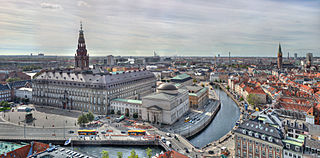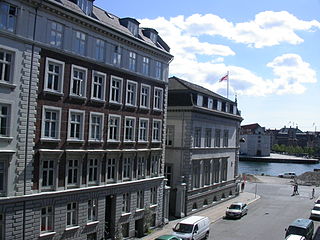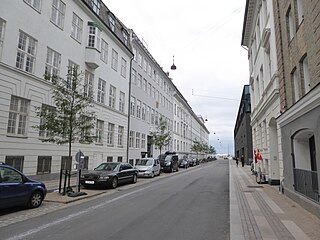
Copenhagen is the capital and most populous city of Denmark, with a population of around 1.4 million in the urban area, and more than 2 million in the wider Copenhagen metropolitan area. The city is on the islands of Zealand and Amager, separated from Malmö, Sweden, by the Øresund strait. The Øresund Bridge connects the two cities by rail and road.

Christiansborg Palace is a palace and government building on the islet of Slotsholmen in central Copenhagen, Denmark. It is the seat of the Danish Parliament, the Danish Prime Minister's Office, and the Supreme Court of Denmark. Also, several parts of the palace are used by the Danish monarch, including the Royal Reception Rooms, the Palace Chapel and the Royal Stables.

Slotsholmen is an island in the harbour of Copenhagen, Denmark, and part of Copenhagen Inner City. The name is taken from the successive castles and palaces located on the island since Bishop Absalon constructed the city's first castle on the island in 1167 at the site where Christiansborg Palace lies today.

Nyhavn is a 17th-century waterfront, canal and entertainment district in Copenhagen, Denmark. Stretching from Kongens Nytorv to the harbour front just south of the Royal Playhouse, it is lined by brightly coloured 17th and early 18th century townhouses and bars, cafes and restaurants. The canal harbours many historical wooden ships.

Indre By, also known as Copenhagen Center or K or Downtown Copenhagen, is an administrative district (bydel) in central Copenhagen, the capital of Denmark. It covers an area of 4.65 square kilometres (1.80 sq mi), has a population of 26,223, and a population density of 5,638 per km².

Christianshavn is a neighbourhood in Copenhagen, Denmark. Part of the Indre By District, it is located on several artificial islands between the islands of Zealand and Amager and separated from the rest of the city centre by the Inner Harbour. It was founded in the early 17th century by Christian IV as part of his extension of the fortifications of Copenhagen. Originally, it was laid out as an independent privileged merchant's town with inspiration from Dutch cities but it was soon incorporated into Copenhagen proper. Dominated by canals, it is the part of Copenhagen with the most nautical atmosphere.

The architecture of Denmark has its origins in the Viking period, richly revealed by archaeological finds. It became firmly established in the Middle Ages when first Romanesque, then Gothic churches and cathedrals sprang up throughout the country. It was during this period that, in a country with little access to stone, brick became the construction material of choice, not just for churches but also for fortifications and castles.

The fortifications of Copenhagen is the broad name for the rings of fortifications surrounding the city of Copenhagen. They can be classified historically as follows:

Holmen is a water-bound neighbourhood in Copenhagen, Denmark, occupying the former grounds of the Royal Naval Base and Dockyards. In spite of its name, deceptively in singular, Holmen is a congregation of small islands, forming a north-eastern extension of Christianshavn between Zealand and the northern tip of Amager.

The Copenhagen Harbour Buses is a system of water buses along the harbourfront of Copenhagen, Denmark, operated by Movia which also operates the city’s regular buses. There are four vessels: Holmen, Bryggen, Nordhavn and Nyhavn. The Harbour Buses are integrated into the Copenhagen public transport system with the same payment system as buses, Metro or DSB trains.

Gammelholm is a predominantly residential neighbourhood in the city centre of Copenhagen, Denmark. It is bounded by the Nyhavn canal, Kongens Nytorv, Holmens Kanal, Niels Juels Gade and the waterfront along Havnegade. For centuries, the area was the site of the Royal Naval Shipyard, known as Bremerholm, but after the naval activities relocated to Nyholm, it came under residential redevelopment in the 1860s and 1870s. The new neighbourhood was planned by Ferdinand Meldahl and has also been referred to as "Meldahl's Nine Streets". Apart from the buildings which face Kongens Nytorv, which include the Royal Danish Theatre and Charlottenborg Palace, the area is characterized by homogeneous Historicist architecture consisting of perimeter blocks with richly decorated house fronts.

Gammel Strand is a street and public square in central Copenhagen, Denmark. On the south side it borders on the narrow Slotsholmens Canal while the north side is lined by a row of brightly coloured houses from the 18th and 19th century. Across the canal, Thorvaldsens Museum and Christiansborg Palace are seen on the island Slotsholmen.
Philip de Lange was a leading Dutch-Danish architect who designed many different types of building in various styles including Dutch Baroque and Rococo.

Sankt Annæ Plads is a public square which marks the border between the Nyhavn area and Frederiksstaden neighborhoods of central Copenhagen, Denmark. It is a long narrow rectangle which extends inland from the waterfront, at a point just north of the Royal Danish Playhouse at the base of the Kvæsthus Pier, now known as Ofelia Plads, until it meets Bredgade. A major renovation of the square was completed in 2016.The Garrison Church is located on the south side of the square. Amaliegade, one of the two axes on which Frederiksstaden is centered, extends from the square.

Jacob Fortling was a German-Danish sculptor, architect and industrialist, described as one of the most industrious people in the Denmark of his day. He came to Denmark at age 18 and embarked on a successful career, first as a sculptor and later also as an architect. He was also engaged in the production of building materials, owning several quarries in Norway. Just outside Copenhagen, on Amager's east coast, he founded Kastrup Værk, a large industrial facility combining a lime plant, a brickyard and a pottery.

Larsens Plads is a waterfront in Copenhagen, Denmark, which runs along the Zealand side of the main harbour from the Nyhavn canal in the south to the Nordre Toldbod area just south of Langelinie to the north. The name refers to a shipyard which used to occupy the grounds but is now more associated with emigration to America after it became a major hub for trans-Atlantic traffic later in the century. It is dominated by Amalienborg Palace with the Amalie Garden and a number of late 18th-century warehouses which has been converted to other uses. The buildings facing the waterfront have their address on the parallel street Toldbodgade.

Gammel Strand station is a Copenhagen Metro station located at Gammel Strand in the Old Town of Copenhagen, Denmark. The station is on the City Circle Line, between Kongens Nytorv and Rådhuspladsen, and is in fare zone 1. The station provides access to the central section of Strøget, Slotsholmen, Christiansborg Palace and Højbro Plads.

Netto-Bådene is an operator of canal tours in the port and canals of Copenhagen, Denmark.

Kvæsthusgade is a short street in the Nyhavn Quarter of central Copenhagen, Denmark. It runs from the mouth of the Nyhavn canal in the south to Ofelia Plads in the north. The rear side of the Royal Danish Playhouse dominates the east side of the street.


















